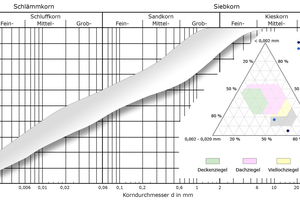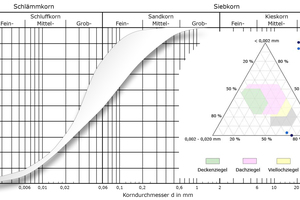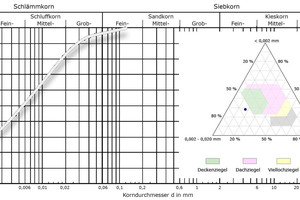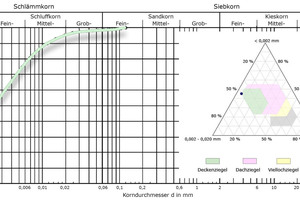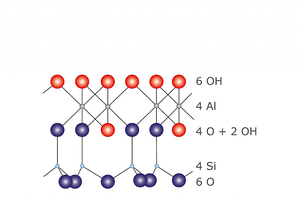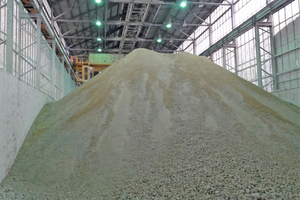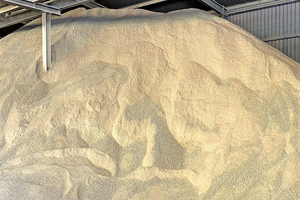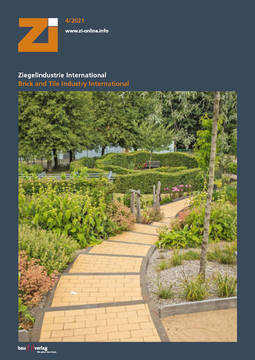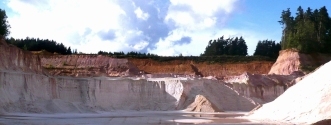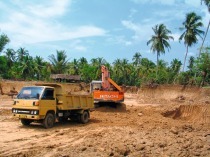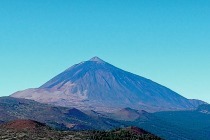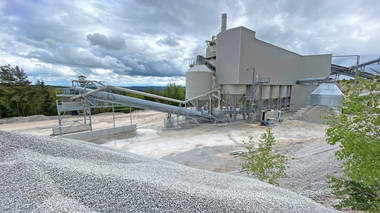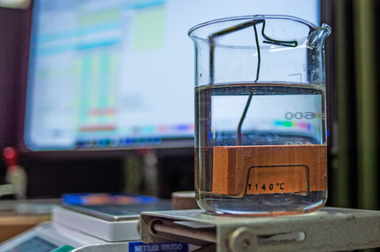Modern raw materials for the clay brick and tile industry
Part 2: Kaolin raw materials from Caminau surface mine
The German clay brick and tile industry has defined sustainability as a key issue for the future and announced climate neutrality by 2050. As a consequence, high-carbon brick clays like marly clays are becoming less important. As an alternative, from a technical point of view, the use of porosifying kaolin raw materials is one possibility.
1 Geological background and site
Not far from the A4 motorway, around 20 km north of the town of Bautzen in Germany, lies the largest coherent kaolin deposit in the former GDR, with an operating area covering 330 hectares. Extraction of the kaolin started back in 1904. After the Second World War, under the state-owned enterprise VEB Kaolinwerk Caminau, large-scale commercial extraction began. Following the political change in 1990, the plant passed into the ownership of Amberger Kaolinwerke Eduard Kick GmbH & Co. KG (AKW) [1]. Dr. Krakow Rohstoffe GmbH is the sales partner for the clay brick and tile industry.
Extracted here are quartz-rich raw kaolins, which are processed with state-of-the-art plant equipment to different washed kaolin grades. These are used mainly as filler kaolins in the paper and chemicals industries. In wet processing, large quantities of secondary raw materials are produced, which are stored in sediment ponds or optionally dewatered on modern equipment and pelletized (»1). Caminau washed kaolins are not only sold in Germany, but exported worldwide by rail and ship.
The geological origin of the Caminau kaolin is connected with the formation of other globally significant kaolin deposits [2]. It can be traced back to a long global interglacial period in geological history, which began with the start of the Upper Cretaceous around 100.5 million years ago and reached its peak around 50.8 million years ago in the Eocene. The global average temperature was up to 14 °C above today’s level. After that began a slow but steady cooling period, which is reflected in the decreasing weathering intensity from the Pliocene.
Following the Palaeogeographic reconstruction, during the Eocene, Central Europe was located at 30 to 40 degrees north latitude. Right up to Scandinavia, there was lush vegetation with tropical rain and amber forests (»2). South of the North Sea Basin, an extensive senkungsfeld, that is an area of depression, existed with large tropical forest areas and low-oxygen carbon sumps, similar to Brazil today [3]. Ideal conditions for weathering of potassium feldspar and the formation of kaolinite with simultaneous liberation of alkalis and silicic acid according to the following reaction equation. At the same time hydroxide ions from the atmosphere were permanently incorporated in the crystal lattice of the new mineral:
4 K Al Si3O8 + 4 H2O -> Al4 [(OH)8 Si4O10] + 2 K2O + 8 SiO2
Potash feldspar + water -> kaolinite + alkalis + silicic acid
As a result of steady infiltration and dissipation of acidic waters, the characteristic kaolin zones were formed above the physically disintegrated starting rock. In the Caminau surface mine, the lower green raw kaolin zone measures up to 20 m thick. On top is an up to 35-m-thick layer of light-coloured raw kaolin. Ice age sediments cover the series of strata up the surface of the terrain to today. Geologically, the Caminau surface mine is located in the Saxothuringian zone of the Variscan, especially at the northern face of the Upper Lusatian uplands. It forms part of the Lusatian granodiorite complex that was formed starting from the Cadomian Orogeny around 650 million years ago in several intrusion phases (»3).
2 Mineralogical and chemical composition
2.1 Green raw kaolin
Characteristic of the green raw kaolin formed in situ from the Lusatian Granodiorite is a very wide and homogeneously distributed particle size band, which ranges from very fine particle sizes d < 0.002 mm to the fine gravel range d = 2 – 6 mm. The maximum particle sizes lie in the silt and sand grain spectrum (»4a).
In mineralogical terms, the green raw kaolin has a comparatively simple composition. According to the average analysis, kaolinite is the dominant phyllosilicate, followed by innercrystalline non-expansive minerals in the mica group. Feldspars from which the kaolinite was formed are only present as relicts. The inference is that a nearly complete weathering process has taken place. With regard to the non-plastic mineral phases, weathering-resistant quartz is the main component (»Table 1).
In chemical terms, silicon and aluminium dominate clearly before all other elements. Alkaline and earth alkaline fluxes are almost completely absent. 2.57 mass% iron is detected in the average analysis. The content of organic carbon averages 0.10 mass% (»Table 2).
2.2 CS 70 kaolin silt
In the sediment pond currently being worked there are five million tonnes of sandy to very sandy kaolin silt. This represents the unqualified by-product from the filler kaolin production. The kaolin pond is a prime example of sedimentation differentiation. In the area of the suspension discharge point, quartz sand dominates. As sedimentation progresses, the quartz sand is successively substituted by kaolin silt. For the mass of the sediment, a grain spectrum with maximum sizes in the coarse silt to fine sand range is probably representative (»4b).
Compared with the green raw kaolin, with the process of particle size fractionation, a clear increase of the phyllosilicate fraction from 52 to 78 mass% results. In contrast, the quartz is reduced to 20 mass%. In the chemical average analysis, this phase shift is reflected in an increased aluminium and a reduced silicon content. Siderite is detected as an accessory, secondarily formed mineral phase.
2.3 CPK ceramic kaolin pellets
Alternatively to deposition in the sediment pond, by-products from the filler kaolin production are dewatered on modern chamber filter presses, pelletized in the circular screen feeder and then dried on the belt dryer. As a result, a kaolin silt practically free of screen particles with a considerable content of very fine particles d < 0.002 mm is obtained (»4c).
With removal of the screen particle fraction, this material consists almost exclusively of phyllosilicates (98 mass%), with kaolinite at 85 mass% clearly dominating before minerals of the mica group with 13 mass%. Chemically, this is reflected in stable aluminium values of over 35 mass%. Compared with the raw kaolin, the oxide-bonded iron is reduced to 1.68 mass%.
2.4 CF-78 R filler kaolin pellets
The filler kaolin used predominantly in the paper industry is characterized by a significant content of very fine grains and maximum particle sizes in the fine and medium silt grain. Less than 5 mass% of the particles have a particle diameter d > 0.02 mm (»4d). With intensive wet processing and multiple classifying steps, it is possible to concentrate the content of kaolinite from 32 mass% in the raw kaolin to 89 mass%. In terms of the chemical composition, the filler kaolin is largely identical to the ceramic kaolin. Relatively small deviations are shown for the parameters aluminium, iron and the even lower content of organic substance.
3 Ceramics-related characteristics
Despite qualitative differences, the kaolin raw materials exhibit similar basic characteristics. They have low body densities and low body thermal conductivities (»Table 3). Cause is the two-layer silicate kaolinite, which has a crucial influence on the material properties and, in contrast to three-layer silicates, has a high content of OH groups in its crystal lattice (»5). This crystal water is released at temperatures between 500 – 700 °C and ensures in this way microporosification of the body. This is reflected in the high losses on ignition. In traditional masonry brick clays and clay marls, liberated CO2 from the carbonates or organic carbon take over this function.
All raw materials from Caminau exhibit low drying shrinkage and should not be classed as drying-sensitive. As a function of the firing temperature, firing shrinkage is minimal to moderate, which correlates with correspondingly low compressive strengths. All raw materials have a high refractoriness and do not fire dense. They are therefore not prone to swelling. The fired colours are always light to creamy white.
Clear differences result in respect of the plasticity and the plastic properties. While the raw kaolin and the kaolin silt only exhibit low plasticity, the washed kaolins are characterized by a high mixing water content with high plastic limits at the same time. From this result medium-plastic properties with high water load. The presented washed kaolins are predestined for the production of high-thermal-insulation bricks on the basis of the carbonate-free bodies. Practical tests have shown that a clay content of around 30 % is necessary in a batch formulation to produce absolutely top-quality products with realistic characteristic values.
4 Volume availability and final remarks
At the Caminaue kaolin plant, up to 600 000 tonnes raw kaolin are extracted per year and refined to produce valuable washed kaolin pellets (»6a,b). In addition, there are five million tonnes kaolin silt in the currently worked sediment pond. Generous expansion areas for future kaolin extraction are currently under successful geological exploration. Caminauer Kaolinwerk GmbH has a its own railway connection, via which easily the largest part of the consignments are handled.
As a result of very low carbon contents, the CO2 process emissions in ceramic firing with a variation of 0.26 – 1.09 mass% can be classed as minimal. For comparison: conventional masonry brick clays and clay marl generally range between 5.0 – 15.0 mass%, sometimes above this. In addition, the body thermal conductivity of conventional clay raw materials is usually much higher/poorer. Anyone really serious about climate neutrality should not wait until 2050, but act straight away [5]. Innovative companies are showing the industry the way.
ISBN 3-9805627-8-7.

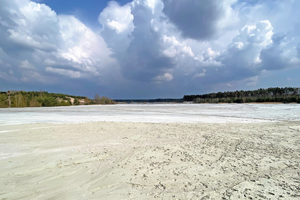
![»2 Palaeogeographic map showing Central Europe at the time of the Eocene, modified from [3]](https://www.zi-online.info/imgs/1/6/8/5/8/9/3/tok_68ff74f196387869be0a02c41e5817f2/w300_h200_x600_y478_Bild_2-648dd693db640722.jpeg)
![»3 The kaolin field on the Lusatian granodiorite, redrawn after [4]](https://www.zi-online.info/imgs/1/6/8/5/8/9/3/tok_2ee4a32bcb24e8d39b639bf073a6ffcf/w300_h200_x600_y392_Bild_3-70b63426f6705a0d.jpeg)
